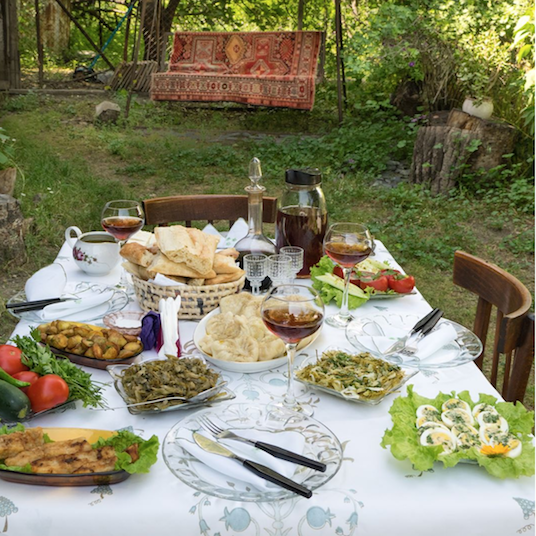
This week saw the inaugural Wines of Georgia tasting in London organised by Sarah Abbott of Swirl Wine Group. The Georgian ambassador wrote an introduction for the catalogue explaining the importance of wine to that small country:
It is no secret that wine is Georgia’s finest ambassador. Currently Georgian wine is exported to 46 countries worldwide promoting Georgian culture and tradition. It also attracts tourists to explore our wine routes. A tourist visiting the country for the first time receives a bottle of wine from the border officer as a welcome gesture, together with a stamp in passport.
Ghetto-ising Georgian wines and saying that they merely exert a strange fascination, is not to see that they have a wider role in today’s world of wine, by reacquainting people with the historical and cultural background of wine. It is not fanciful to say that Georgia is giving back something very special to the wine world.

One thinks of how wine has been recently shaped by the market-place and commercial requirements as well as the demands of regulatory bodies (all pushing towards homogenisation). Georgia has been somewhat insulated against these forces and survives with its confident cultural identity intact. Georgia is, of course, the birthplace of wine and the country with the oldest and most continuous tradition of winemaking. The etymology of the word ‘wine’ is said to stem from the Georgian word ????? (gvino). Wine for Georgians is much more than just a beverage. Historically, wine was not only the basis of economic wealth, but also part of spiritual culture.
When one thinks of Georgia now, one thinks of the skin contact wines, the qvevri, the natural winemaking and the amazing gastronomy of the country. Wine is sacramental in Georgia; there is a hard ethos of hospitality and celebratory drinking, something that we have lost over the years as wine becomes a product fit for purpose. Wine is certainly hard-wired into the Georgian mentality.
It is not fanciful to say that Georgia is giving back something very special to the wine world.
But Georgia is by no means an homogenous wine country. There are different regions – Kakheti, Kartli, Imereti, Guria, Samegrelo… different and proud local traditions of winemaking, and, of course, 500 + grape varieties to choose from, many of which are being rehabilitated as we speak.
And then there are the qvevri. A pot is not just pot. Qvevri-making is a UNESCO protected craft. The symbolism of the qvevri is potent and integral to Georgian wine culture. The pot is made out of clay, lined with beeswax, and then buried in the ground where it remains. It holds the wine during the fermentation, and, symbolically-speaking, gives birth to it. (There is notion that the qvevri is like a womb, the skin, stems and pips are the mother and the wine is the baby). The qvevri shapes the wine too; bequeathing subtle but tell-tale flavours.
Wine for Georgians is much more than just a beverage. Historically, wine was not only the basis of economic wealth, but also part of spiritual culture.
Our latest batch of Georgian wines arrived a few weeks ago. We are beginning to glimpse a change in style. Rather than extracting everything at all costs with long macerations, and allowing the juice to oxidise over the summer, the wines seem to be brighter, less extractive, less raw and more lifted and with finer tannins. Many are bottled earlier for freshness. More growers seem to be making non-skin contact versions too. It is not just about length of maceration; it’s also about balance. The Mtsvane from Mandili (Marina Kurtanidze) is a case in point. The deep salmon-pink colour is inviting, the nose speaks of so many things including roasted apricots, crystallised citrus even grilled mushrooms and the palate encompasses tea, sake and a pink grapefruit tangerine-tang. Like the best Georgian wines, it possesses earthiness and real umami flavours balanced by energetic acidity and fine-grained tannins. Texture is an important dimension in wine, but it requires fluidity to bring all the components into relief. This wine has that fluidity.

Saperavis from John Okro, Zurab Topuridze and Pheasant’s Tears show a gentler touch, an influence from the wines of Jura and Beaujolais, rather than the impenetrable inkiness and coruscating tannins that one might traditionally associate with this variety.
We are beginning to glimpse a change in style…the wines seem to be brighter, less extractive, less raw and more lifted and with finer tannins.
The Wines of Georgia Tasting had around 90 wines from 30 + growers from the various regions around the country. Whilst a very nice representation, this is also but a drop in the ever-fermenting Georgian wine ocean. It is a start, an educational introduction to some of the grapes and styles of winemaking. There were some lovely, distinctive wines on show as well as some more commercial, international styles. One month ago, there were no fewer three parallel artisan growers’ tastings in Georgia itself, which, by all accounts, introduced a lot of people to some fabulous new wines and new growers (as well as many old favourites). Meanwhile, producers from all over the world are making the pilgrimage to this tiny country to taste and understand, and to explore new ideas from ancient traditions. But it is more than that, the wines have peculiar integrity and singular flavours. This authenticity is to be treasured.

